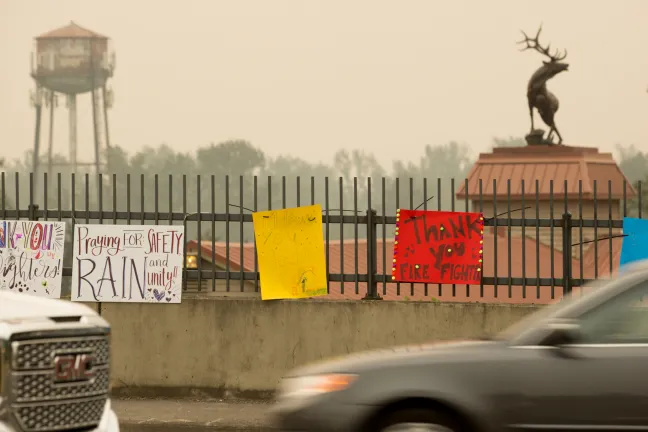Climate change has subjected Oregon’s forests to ever longer wildfire seasons and deprives the state’s peaks from snowpack that feeds rivers and lakes and reservoirs.
According to a report released Oct. 8, 2018 by the United Nation’s Intergovernmental Panel on Climate Change, the health and environmental impacts will be increasingly dire if global temperatures rise 1.5 degrees Celsius (2.7 degrees Fahrenheit) above pre-industrial levels; and that’s likely to happen by 2040 if world leaders don’t take immediate and drastic action.
Human-caused emissions of carbon dioxide would need to fall by nearly half from 2010 levels by 2030 to avoid catastrophic damage, the report, drafted by 91 scientists and reviewed by experts from 40 countries, determined.
Parts of the world have already exceeded that threshold. Since the 1970s, most land regions have been warming faster than the global average, for example. This means that warming in many regions has already exceeded 1.5°C above pre-industrial levels.
One-in-five people live in places that have already experienced warming in at least one season that is greater than 1.5°C above pre-industrial levels, leading to extreme weather, droughts, floods, sea level rise, biodiversity loss, and unprecedented risks to vulnerable populations, the climate scientists found.
In the Pacific Northwest, climate change means hotter temperatures and a drier climate.
“What we’ve been experiencing in terms of heat and air quality is linked to what the Intergovernmental Panel on Climate Change found,” said Dr. Jae Douglas, Environmental Health Director. Multnomah County Environmental Health tracks the health impacts of climate change, and she said every individual action counts.
If one person leaves her car in the garage one day a week, the air quality is better that day because she did so. When a person eats a plant-based meal, uses a low-flow shower or uses LED lights, the environment is better off.
“On a daily-action standpoint, the more choices you make on an individual, the better off we are. But It’s not enough for you to change your light bulb,” she said. “Individual choices didn’t get us here, and individual choices won’t get us out of this. If we don’t collectively take action, we’re in trouble.”
Consider:
-
Average temperatures in the northwest have increased 1.5 degrees Fahrenheit (0.8 degrees Celsius) since the 1950s. And the coldest day of the year in the northwest is 4.8 degrees warmer on average, according to a 2017 study by the National Climate Science Special Report.
-
Multnomah County is projected to log 24 days above 90 degrees in 2050, compared to 4 days in 1980, according to the Centers for Disease Control and Prevention and the data from the National Weather Service.
-
The average length of wildfire season in the northwest has increased five-fold between 1970 and 2000, from 23 days to 116 days. And climate scientists predict Oregon’s record-low snow pack in 2015 will become typical by mid-century, according to the 2017 Oregon Climate Assessment Report.
Brendon Haggerty, senior technical staff in Environmental Health, finds hope in the region’s
Individuals can also have a big impact by the choices they make day-to-day. A plant-based diet can cut a person’s individual's dietary carbon load by up to 73 percent, research suggests. And city-dwellers can always opt to bike, walk, hop the bus or carpool before choosing to commute alone by car.
“In the long-term, when you think about replacing your furnace, or replacing your car, or when you decide where to live next,” Haggerty said, “when you make those big long-term investments, don’t get stuck in something that digs us deeper in the hole.”
Lawmakers and voters are also considering initiatives that could have a sizable impact on Oregon emissions.
The statewide cap and invest legislation, also known as the Clean Energy Jobs bill, is expected to get serious attention in Salem during the 2019 session. It would put a price on carbon, tie Oregon to the California emissions trading market, and generate revenue for energy efficiency, renewables, and transportation.
The Portland Clean Energy Fund, also known as
County leaders are keeping a close eye on state and local efforts, in addition to looking at what it can do as the Board of Commissioners.
"This report reiterates how critical it is that every single person, city, county, state, and country join in the work to reduce carbon emissions,” said Commissioner Jessica Vega Pederson. “Multnomah County has taken the lead on this by enacting its Climate Action Plan and committing to 100 percent renewable energy by 2050. I'm excited to see so much grassroots support for legislation that accounts for the cost of climate pollution, and I will be working hard next year to see Oregon take another step towards leading the way on fighting climate change."
The county board supports putting a price on carbon, which researchers believe could cut national greenhouse gas emissions by more than half by 2050 — but only if the county starts now, sets the price-per-ton at $50 and raises that cost incrementally.
“We need a price on carbon,” said John Wasiutynski, director of Multnomah County’s Office of Sustainability. “Climate change is not longer a distant threat. We’re talking severe impacts we’re experiencing today.”
“Make your voice heard. Make Practical changes. Just because you can’t change everything, doesn’t mean you can’t change something. It’s the only way change has every happened. It’s the only way change ever will happen.”

